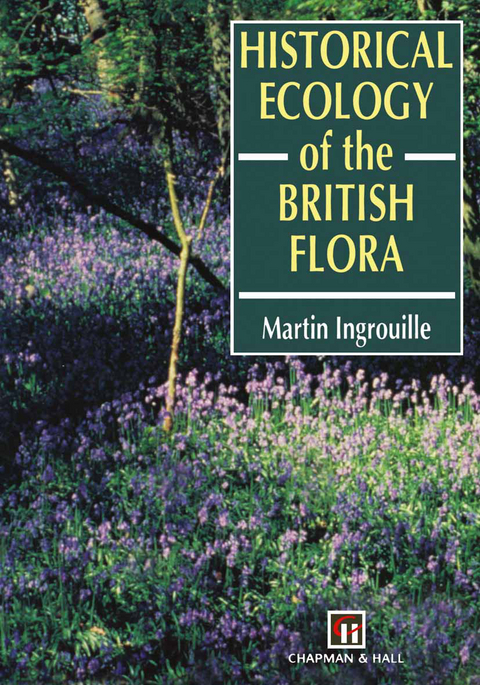
Historical Ecology of the British Flora
Chapman and Hall (Verlag)
978-0-412-56150-4 (ISBN)
The native British flora is today relatively ant species on the continent, such as Picea impoverished. Today the British Isles has a abies (Norway spruce), did not get into Britain flora of only about 1500 species of native in time. However, we must not over flowering plants. France and Spain, each emphasize the importance of Britain being an geographically only about twice the area, island. A comparison of floras on either side have 3-4 times as many species each. The of the English Channel shows that there are comparison is more marked when consider species present in England and not in ing the endemic species, those specialities of northern France as well as vice versa. Many each geographical region which grow of the species present in northern France but nowhere else. If only normal sexual species absent from England are weeds adapted to are considered, then there are only about 13 French agriculture. Others may be limited endemic species in the British Isles while 1000 not by the sea but by the climate. species are endemic to Spain. Nevertheless, the example of Ireland, However, the poverty of the British flora is which was isolated much earlier than the rest not a unique phenomenon. The whole of of the British Isles, does show the effect of north-western Europe, an area including isolation because it does have a much poorer northern France and much of Germany and flora and fauna.
1 The fossil flora: 440 million to 14 thousand years ago.- 1.1 Hard evidence from the past.- 1.2 The Silurian and Lower Devonian.- 1.3 The Middle and Upper Devonian.- 1.4 The Lower Carboniferous.- 1.5 The Upper Carboniferous.- 1.6 The Permian and Triassic.- 1.7 The Jurassic.- 1.8 The Cretaceous.- 1.9 Recognizing the past.- 1.10 Tertiary floras.- 1.11 The London Clay flora.- 1.12 Oligocene floras beside mountain lakes and streams.- 1.13 The Quaternary period.- 1.14 The Anglian glaciation.- 1.15 Late Pleistocene interglacials.- 1.16 The last cold stage, the Devensian stage.- 1.17 A relic glacial vegetation?.- 1.18 The ice melts.- 2 The ‘natural’ vegetation of the British Isles: 14 000 to 5000 years ago and its survival today.- 2.1 The Late Devensian.- 2.2 Plants, climate and soils.- 2.3 The Windermere and Woodgrange interstadials.- 2.4 A cold snap, the Loch Lomond and Nahanagan stadials.- 2.5 Postglacial warmth.- 2.6 A surviving herb flora.- 2.7 The spread of the wildwood.- 2.8 The wildwood, primary and ancient woodlands.- 2.9 The ecology of the wildwood.- 2.10 ‘Natural’ vegetation?.- 3 The managed landscape: fields, pastures, woods and gardens.- 3.1 The elm decline.- 3.2 Clearings in the wildwood.- 3.3 Marking out the land in the Bronze Age.- 3.4 Ownership, rights and duties.- 3.5 Exploiting the countryside.- 3.6 Evolution in our flora.- 3.7 The exotic flora.- References.
In short, the book provides an essential explanation of the diversity of today's vegetation and landscape - Neu!; The book is written in an easy and accessible style..., anyone with a serious interest in the history and ecology of our flora and its conservation would do well to add this to their shelves - Natural World; This is the sort of book that everyone should be grateful to the author for producing. It covers an immense sweep of time and material, and a wide range of people from undergraduates and researchers to the 'educated layman (person)' will find it of great value. - Landscape History; ...such readability and authority that the book is hard to put down....The author is to be congratulated on producing such a comprehensive and accessible book. - Tree News.
| Erscheint lt. Verlag | 31.5.1995 |
|---|---|
| Zusatzinfo | XII, 352 p. |
| Verlagsort | London |
| Sprache | englisch |
| Maße | 178 x 254 mm |
| Themenwelt | Naturwissenschaften ► Biologie ► Botanik |
| Naturwissenschaften ► Biologie ► Evolution | |
| Naturwissenschaften ► Geowissenschaften ► Mineralogie / Paläontologie | |
| ISBN-10 | 0-412-56150-6 / 0412561506 |
| ISBN-13 | 978-0-412-56150-4 / 9780412561504 |
| Zustand | Neuware |
| Haben Sie eine Frage zum Produkt? |
aus dem Bereich


